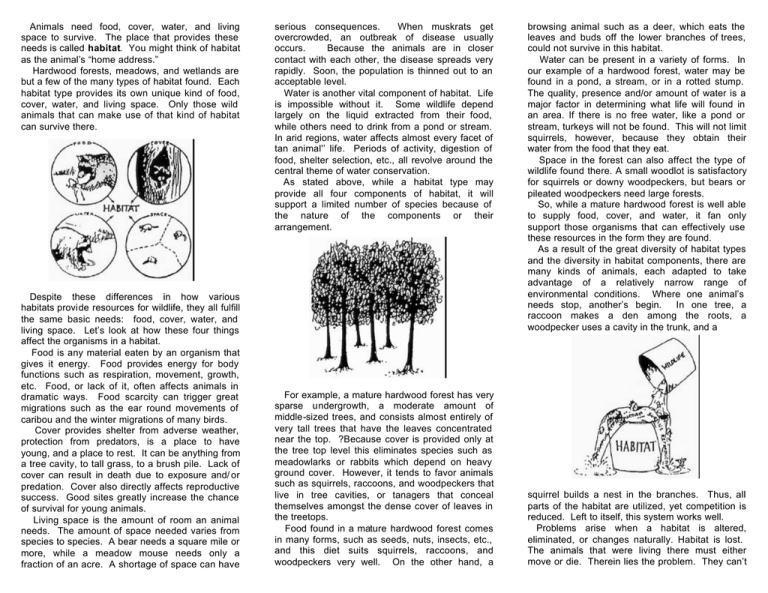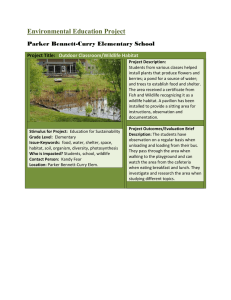Animals need food, cover, water, and living
advertisement

Animals need food, cover, water, and living space to survive. The place that provides these needs is called habitat. You might think of habitat as the animal’s “home address.” Hardwood forests, meadows, and wetlands are but a few of the many types of habitat found. Each habitat type provides its own unique kind of food, cover, water, and living space. Only those wild animals that can make use of that kind of habitat can survive there. Despite these differences in how various habitats provide resources for wildlife, they all fulfill the same basic needs: food, cover, water, and living space. Let’s look at how these four things affect the organisms in a habitat. Food is any material eaten by an organism that gives it energy. Food provides energy for body functions such as respiration, movement, growth, etc. Food, or lack of it, often affects animals in dramatic ways. Food scarcity can trigger great migrations such as the ear round movements of caribou and the winter migrations of many birds. Cover provides shelter from adverse weather, protection from predators, is a place to have young, and a place to rest. It can be anything from a tree cavity, to tall grass, to a brush pile. Lack of cover can result in death due to exposure and/ or predation. Cover also directly affects reproductive success. Good sites greatly increase the chance of survival for young animals. Living space is the amount of room an animal needs. The amount of space needed varies from species to species. A bear needs a square mile or more, while a meadow mouse needs only a fraction of an acre. A shortage of space can have serious consequences. When muskrats get overcrowded, an outbreak of disease usually occurs. Because the animals are in closer contact with each other, the disease spreads very rapidly. Soon, the population is thinned out to an acceptable level. Water is another vital component of habitat. Life is impossible without it. Some wildlife depend largely on the liquid extracted from their food, while others need to drink from a pond or stream. In arid regions, water affects almost every facet of tan animal'’ life. Periods of activity, digestion of food, shelter selection, etc., all revolve around the central theme of water conservation. As stated above, while a habitat type may provide all four components of habitat, it will support a limited number of species because of the nature of the components or their arrangement. For example, a mature hardwood forest has very sparse undergrowth, a moderate amount of middle-sized trees, and consists almost entirely of very tall trees that have the leaves concentrated near the top. ?Because cover is provided only at the tree top level this eliminates species such as meadowlarks or rabbits which depend on heavy ground cover. However, it tends to favor animals such as squirrels, raccoons, and woodpeckers that live in tree cavities, or tanagers that conceal themselves amongst the dense cover of leaves in the treetops. Food found in a mature hardwood forest comes in many forms, such as seeds, nuts, insects, etc., and this diet suits squirrels, raccoons, and woodpeckers very well. On the other hand, a browsing animal such as a deer, which eats the leaves and buds off the lower branches of trees, could not survive in this habitat. Water can be present in a variety of forms. In our example of a hardwood forest, water may be found in a pond, a stream, or in a rotted stump. The quality, presence and/or amount of water is a major factor in determining what life will found in an area. If there is no free water, like a pond or stream, turkeys will not be found. This will not limit squirrels, however, because they obtain their water from the food that they eat. Space in the forest can also affect the type of wildlife found there. A small woodlot is satisfactory for squirrels or downy woodpeckers, but bears or pileated woodpeckers need large forests. So, while a mature hardwood forest is well able to supply food, cover, and water, it fan only support those organisms that can effectively use these resources in the form they are found. As a result of the great diversity of habitat types and the diversity in habitat components, there are many kinds of animals, each adapted to take advantage of a relatively narrow range of environmental conditions. Where one animal’s needs stop, another’s begin. In one tree, a raccoon makes a den among the roots, a woodpecker uses a cavity in the trunk, and a squirrel builds a nest in the branches. Thus, all parts of the habitat are utilized, yet competition is reduced. Left to itself, this system works well. Problems arise when a habitat is altered, eliminated, or changes naturally. Habitat is lost. The animals that were living there must either move or die. Therein lies the problem. They can’t avoid the situation by moving, so death of some animals is the only answer. Why can’t they move? In any given area, animals reproduce and their population increases until a shortage of resources stops the increase. This level where the increase stops is called the carrying capacity and works much like water in a bucket. If you have a gallon bucket, and you try top put two gallons of water into it, the bucket overflows. Much the same thing happens with wildlife populations and habitat. (But unlike a bucket, carrying capacity changes with time, weather, people’s influence, causing carrying capacity to increase or decrease.) If reproduction or immigration causes the population to exceed the number of animals the environment can support, some animals must die. Animals can’t simply move, because any place they might move to is already supporting all the animals it can and these immigrants would simply cause a geographic shift in the problem. So, when habitat changes or is eliminated, the only answer is that some animals must die. (They will probably move first and perhaps some displace some animals elsewhere if they prove to be more successful competitors, but sooner or later the chain reaction of displaced animals stops and some animals die.) This is the reason that habitat conservation is so important. Whether habitat destruction is rapid and populations are lost quickly, or whether the process is more subtle, the result is the same – wildlife without habitat is doomed. What is the answer? There is no single or simple one. Certainly wise land use, and careful management will help, but these measures will e effective only if they are enacted and supported by all of us. Habitat is the key to the survival of wildlife and we are the keys to the survival of habitat. To find out what you can do, write to MUCC, P.O. Box 30235, Lansing, MI 48909, and order “Conservation Planting” ($1.00 postpaid), a booklet that describes methods of landscaping that suit both people and wildlife. Also, consult your local Soil Conservationists and Michigan State University Extension Agent for more publications and advice. MICHIGAN UNITED CONSERVATION CLUBS P.O. Box 30235 Lansing, MI 48909 517/371-1041




